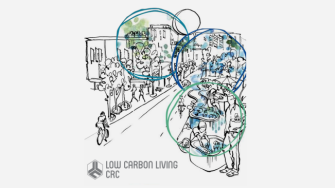
Project objectives
This project aims to develop a robust and tangible microclimate and urban heat island mitigation decision-support tool that bridges the gap between research on urban microclimates and its practical application. Project objectives are:
- to provide governments and built environment industries with a decision-support tool to inform urban policy, development assessment and planning practices related to potential building and urban interventions, used to cool streetscapes and cities, decrease energy consumption, protect the population’s vulnerable health-wise, and improve conditions of comfort.
- to integrate scientific models with a range of mitigation techniques to perform urban heat island mitigation analysis across both building and urban scales, such as building coatings and roofs, urban form and density, greenery and infrastructure.
- to develop an Urban Heat Island Mitigation Performance Index to support governments in establishing performance targets for their planning control. The Index will indicate impact on street level temperature, health and mortality, precinct level energy consumption, etc.
Key benefits
- Convenient, easy and efficient to use by governments, developers and planners to mitigate vulnerability to climate change, in particular urban heat island mitigation;
Supports evidence-based decisions and strategies relating to low carbon and climate adaptation in urban development processes;
Fills the gap between research and practical application of urban microclimates.
Dr Lan Ding, UNSW
Complete
01/2017 to 12/2018
- Publications
- Project steering committee
- Partners
- Project participants
- News
Peer Reviewed Research Publications
RP2023: Journal Article: Urban heat island and overheating characteristics in Sydney, Australia. An analysis of multiyear measurements
It has become increasingly important to study the urban heat island phenomenon due to the adverse effects on summertime cooling energy demand, air and water quality and most importantly, heat-related illness and mortality. The present article analyses the magnitude and the characteristics of the urban heat island in Sydney, Australia. Climatic data from six meteorological stations distributed around the greater Sydney region and covering a period of 10 years are used. It is found that both strong urban heat island (UHI) and oasis phenomena are developed.
The average maximum magnitude of the phenomena may exceed 6 K. The intensity and the characteristics of the phenomena are strongly influenced by the synoptic weather conditions and in particular the development of the sea breeze and the westerly winds from the desert area. The magnitude of the urban heat island varies between 0 and 11°C, as a function of the prevailing weather conditions. The urban heat island mainly develops during the warm summer season while the oasis phenomenon is stronger during the winter and intermediate seasons. Using data from an extended network of stations the distribution of Cooling Degree Days in the greater Sydney area is calculated.
It is found that because of the intense development of the UHI, Cooling Degree Days in Western Sydney are about three times higher than in the Eastern coastal zone. The present study will help us to better design and implement urban mitigation strategies to counterbalance the impact of the urban heat island in the city.
DOI 10.3390/su9050712
CRCLCL Project Reports
RP2023: Microclimate and Urban Heat Island Mitigation Decision-Support Tool
This project was carried out by UNSW Sydney and Swinburne University in collaboration with government and industry partners. This report briefly outlines the achievements of the project, incorporating several previously published reports and case studies (Craft et al., 2019; Ding and Craft, 2019) in addition to two new case studies in Parramatta and Macarthur Heights.
The main outcomes of the project include the following two online tools:
Microclimate and Urban Heat Island Mitigation Decision Support Tool has restricted access. Login credentials can be requested from UHI-Index@unsw.edu.au A brief video is available here. The Urban Heat Island Mitigation Index tool is publicly available.
The report begins with project objectives, framework and identification of exemplar precincts for demonstrating the utility of the microclimate and urban heat island decision-support tool (UHI-DS Tool). The methods used for developing the tool are then described, followed by the key findings from three case studies that demonstrate the efficacy of the tool. Finally, the Urban Heat Island Mitigation Index is introduced, before concluding remarks are given on the project outcomes.
RP2023: Microclimate and Urban Heat Island Mitigation Decision-Support Tool (short report) (6387855 PDF)
Fact sheet
RP2023 FACTSHEET: Cooling Our Cities - A Decision Support Tool for Reducing Urban Heat
Cities are vulnerable to temperatures, and the task of cooling them has proved challenging. The CRCLCL is developing a decision-support tool that bridges the gap between research and practical application in urban microclimates by helping governments, developers and planners to mitigate vulnerability to urban heat island effects.
Factsheet: Cooling Our Cities - A Decision Support Tool for Reducing Urban Heat (861522 PDF)
The Project Steering Committee consists of representatives from
- AECOM
- BlueScope Steel
- City of Sydney
- Greater Sydney Commission
- Inner West Council
- NSW Department of Finance, Services & Innovation (Emergency Information Coordination Unit)
- NSW Office of Environment and Heritage (OEH)
- Parramatta City Council
- Southern Sydney Regional organization of Councils (SSROC)
- Stockland
- Swinburne University
- University of New South Wales (UNSW)
- UrbanGrowth NSW
- Waverley Council
- Western Sydney Regional Organization of Councils (WSROC)
- CRC for Low Carbon Living
Partners on this project
- UNSW Sydney
Project participants
News Article
New urban development decision-support tool takes on the heat
As Australian cities heat up, the need for local governments and planning practices to address rising temperatures and the resulting urban heat island effect (UHI), is being assisted by an innovative, online UHI mitigation decision-support tool, funded by the CRC for Low Carbon Living.
RP2023: Microclimate and Urban Heat Island Mitigation Decision-Support Tool
The Microclimate and Urban Heat Island Mitigation Decision-Support Tool brings together scientific models, case studies and broad guidelines to help government and built environment industry reference top heat mitigation strategies and effects, relative to their city.